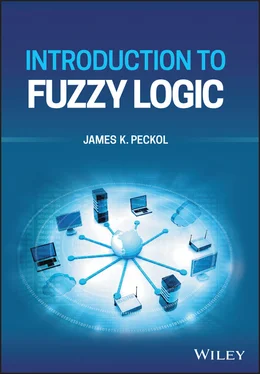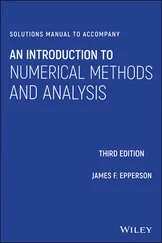James K. Peckol - Introduction to Fuzzy Logic
Здесь есть возможность читать онлайн «James K. Peckol - Introduction to Fuzzy Logic» — ознакомительный отрывок электронной книги совершенно бесплатно, а после прочтения отрывка купить полную версию. В некоторых случаях можно слушать аудио, скачать через торрент в формате fb2 и присутствует краткое содержание. Жанр: unrecognised, на английском языке. Описание произведения, (предисловие) а так же отзывы посетителей доступны на портале библиотеки ЛибКат.
- Название:Introduction to Fuzzy Logic
- Автор:
- Жанр:
- Год:неизвестен
- ISBN:нет данных
- Рейтинг книги:4 / 5. Голосов: 1
-
Избранное:Добавить в избранное
- Отзывы:
-
Ваша оценка:
- 80
- 1
- 2
- 3
- 4
- 5
Introduction to Fuzzy Logic: краткое содержание, описание и аннотация
Предлагаем к чтению аннотацию, описание, краткое содержание или предисловие (зависит от того, что написал сам автор книги «Introduction to Fuzzy Logic»). Если вы не нашли необходимую информацию о книге — напишите в комментариях, мы постараемся отыскать её.
Learn more about the history, foundations, and applications of fuzzy logic in this comprehensive resource by an academic leader Introduction to Fuzzy Logic
Introduction to Fuzzy Logic
Introduction to Fuzzy Logic
Introduction to Fuzzy Logic — читать онлайн ознакомительный отрывок
Ниже представлен текст книги, разбитый по страницам. Система сохранения места последней прочитанной страницы, позволяет с удобством читать онлайн бесплатно книгу «Introduction to Fuzzy Logic», без необходимости каждый раз заново искать на чём Вы остановились. Поставьте закладку, и сможете в любой момент перейти на страницу, на которой закончили чтение.
Интервал:
Закладка:
Finally, I extend a thank you to my many teachers, friends, colleagues, and students who I've had the pleasure of knowing and working with over the years.
About the Author
James K. Peckol, Ph.D., is a Principal Lecturer Emeritus in the Department of Electrical and Computer Engineering at the University of Washington, Seattle, USA, where he has been named Teacher of the Year three times and Outstanding Faculty twice. He is also the founder of Oxford Consulting, Ltd., a product design and development consulting firm. The author is a member of Tau Beta Pi, Who’s Who in the World, Who’s Who in Science and Engineering , and has been presented with the Marquis Who’s Who Lifetime Achievement Award.
His background spans over 50 years as an engineer and educator in the fields of software, digital, medical, and embedded systems design and development. Also, the author has published first and second editions of the book Embedded Systems: A Contemporary Design Tool .
As an engineer in the aerospace, commercial, and medical electronics industries, the author has worked on and contributed to the design and development of test systems for military aircraft navigation systems and radar systems, the Apollo color camera, various weather satellites, the Mars Viking Lander , flight control systems for a number of commercial aircraft, production of high‐quality electronic test instruments and measurement systems, and several defibrillation systems. Academic experience spans more than 25 years of developing and teaching software, digital design, fuzzy logic, approximate reasoning, networking, and embedded systems design courses for students from academe and industry with experience ranging from limited hardware or software backgrounds to those at the junior, senior, graduate, and industrial levels.
Introduction
THINGS TO LOOK FOR…
The topics that will be covered in the book.
Important first steps when beginning a new design.
Some of the strengths, applications, and advantages of fuzzy logic.
The differences between crisp and fuzzy logic.
Is fuzzy logic a newly developed technology?
Who is using fuzzy logic?
Should fuzzy logic be used for all designs?
Should a fuzzy system be implemented in hardware or software?
Where might tools called perceptrons and threshold logic be used?
What should we do after we have designed and built the hardware and firmware for our system?
I.1 Introducing Fuzzy Logic, Fuzzy Systems, and • • • • •
This section begins with some personal philosophy about fuzzy logic, fuzzy systems, and other devices. It begins with what fuzzy logic is and presents some introductory questions and answers about the field. It compares and contrasts fuzzy logic with the traditional classic or crisp logic and concludes with a high‐level view of the basic design and development process and potential applications for both approaches. In addition to fuzzy logic, this text provides a brief review of classical logic and presents and discusses the related areas of threshold logic and artificial neurons also termed perceptrons.
I.2 Philosophy
The chapters ahead bring us into the interesting world of threshold logic, fuzzy logic, and perceptrons. Welcome. The approach and views on solving engineering problems presented in this work reflect things that I have learned throughout my career. Yours will probably be a bit different, particularly as you learn and develop your skills and as the technology evolves. My approach has been augmented by the views and approaches of many very creative engineers, scientists, mathematicians, and philosophers dating back centuries.
We see here the two main themes that will be interwoven through each of the chapters ahead. With each new design, our first look should be from the outside. What are we designing? How will people use it – what is its behavior ? What effect will it have on its operating environment – what are the outputs ? What will be the effect of its operating environment on it – what are its inputs ? How well do we have to do the job – what are the constraints ?
We want to look at the high‐level details first and then go on to the lower. We can borrow the idea of the public interface (an outside view) to our system from our colleagues working on object‐centered designs. Our first view should be of the public interface to our system – we should view it from the outside and then move to the details inside.
I.3 Starting to Think Fuzzy – Fuzzy Logic Q&A
We'll open this book by introducing fuzzy logic. Along our path, we use, design, and develop tools, techniques, and knowledge from just about every other discipline in electrical engineering and computing science.
OK, let's start. Other than an interesting name, exactly what is fuzzy logic? Many people have heard something about fuzzy logic but are not quite sure what it is, what it means, or what's fuzzy about it. Let's try to answer those questions and several of the other more common ones.
Despite its amusing and seemingly contradictory name, fuzzy logic is not a logic that is fuzzy. Exactly the opposite is true. It is a way of capturing the vagueness and imprecision that are so common in our everyday languages and thinking. Capturing and representing such vagueness and imprecision in terms that a computer or learning system can understand and work with becomes the challenge.
Fuzzy logic can represent statements that are completely true or false, and it can also represent those that are partially true and/or partially false. Classical crisp logic lives in a black‐and‐white, “yes” and “no” world. Fuzzy logic admits shades of gray. Such an ability to represent degrees of truth using what are called hedges and linguistic variables makes fuzzy logic very powerful for representing vague or imprecise ideas.
I.4 Is Fuzzy Logic a Relatively New Technology?
Not really. Although fuzzy logic has been generating a lot of interest in this country recently, it is far from new. Lotfi Zadeh (1965), of the University of California at Berkeley, proposed many of the original ideas when he published his first famous research paper on fuzzy sets in 1965. Japanese companies have been using fuzzy logic for over 50 years. They have been granted over 2000 patents and have designed fuzzy logic into hundreds of products ranging from elevator and traffic control systems to video cameras and refrigerators.
One frequently cited example is a one‐button washing machine. This machine senses the size of the load of clothes, the amount and type of dirt and then selects the proper quantity of soap, water level, water temperature, and washing time. Fuzzy logic has also been applied to the classic driverless truck‐backer‐upper problem and automatic flight control for helicopters.
I.5 Who Is Using Fuzzy Logic in the United States?
Companies in the United States utilizing fuzzy logic in contemporary designs include Eaton Industrial Controls, Motorola, NCR, Intel, Rockwell, Togai InfraLogic, NASA, Gensym, Allen‐Bradley Co., General Electric, and General Motors. Some of the fields using fuzzy logic–related technologies include linear and nonlinear control, data analysis, pattern recognition, operations research, and financial systems.
The list of companies outside of the United States becoming involved in developing products that use fuzzy logic or in producing tools for designing fuzzy logic systems is growing at rapid rate.
I.6 What Are Some Advantages of Fuzzy Logic?
Fuzzy logic works very well in conjunction with other technologies. In particular, it provides accurate responses to ambiguous, imprecise, or vague data. Because fuzzy logic allows ideas to be expressed in linguistic terms, it offers a formal mathematical system for representing problems using familiar words.
Читать дальшеИнтервал:
Закладка:
Похожие книги на «Introduction to Fuzzy Logic»
Представляем Вашему вниманию похожие книги на «Introduction to Fuzzy Logic» списком для выбора. Мы отобрали схожую по названию и смыслу литературу в надежде предоставить читателям больше вариантов отыскать новые, интересные, ещё непрочитанные произведения.
Обсуждение, отзывы о книге «Introduction to Fuzzy Logic» и просто собственные мнения читателей. Оставьте ваши комментарии, напишите, что Вы думаете о произведении, его смысле или главных героях. Укажите что конкретно понравилось, а что нет, и почему Вы так считаете.












